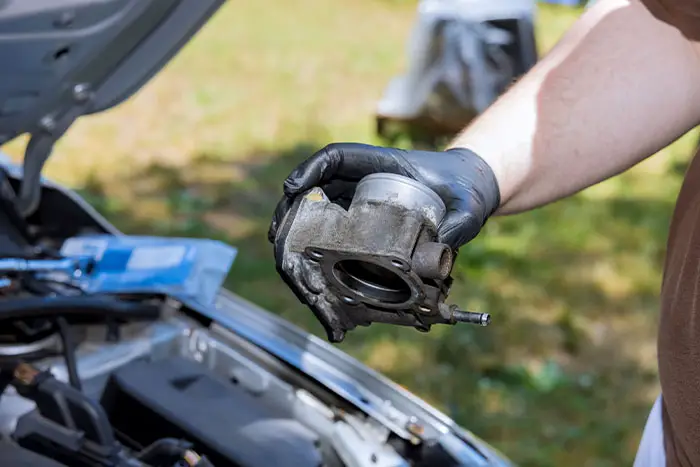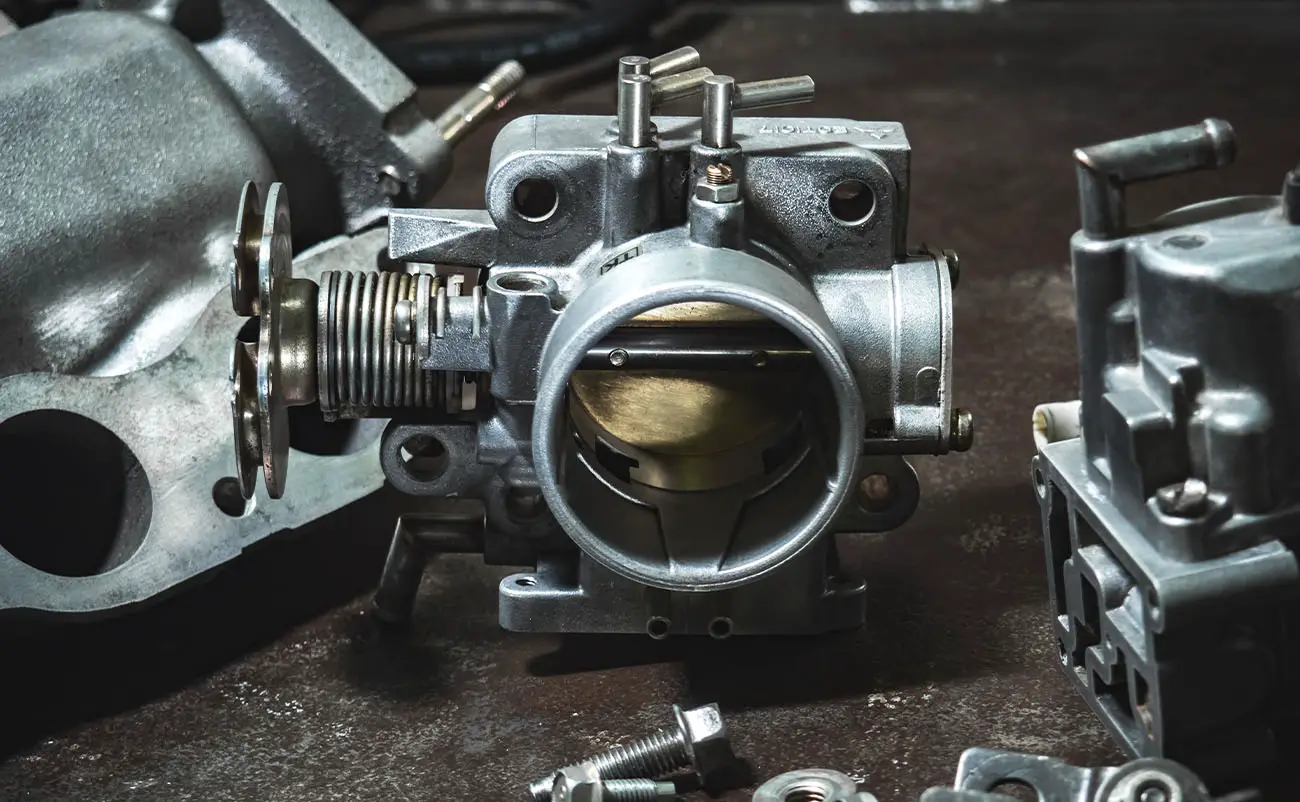Your car’s throttle body plays a crucial role in engine performance. When you press the gas pedal, the throttle body allows more air into the combustion chamber. In turn, this causes the fuel injection system to spray more fuel and the power of your engine increases. The engine’s performance will suffer if the throttle body is bad or dirty. There are several symptoms you might notice, but a bad throttle body will quickly become apparent. Your car may continue to run, but it will not run smoothly. Here are the most common bad or dirty throttle body symptoms that you might notice.
Table of Contents
8 Signs Of A Bad Throttle Body

A bad throttle body can prevent airflow from getting to the combustion chamber and can cause your engine to have too much fuel. On the other hand, it could allow too much air into the engine and cause your motor to starve for fuel. Either way, you’ll notice a problem, and here are the most common symptoms of a bad throttle body you will see.
— Check Engine Light
The computer in your car is very smart and can tell when things go wrong. It uses hundreds of sensors located through different parts of the vehicle, and it will illuminate the check engine light when a problem is encountered. Since a bad throttle body can affect the amount of air entering the combustion chamber, the computer can usually sense a problem. There may be a discrepancy between the amount of air entering the air intake and the amount making it into the engine or some other issue. If you see a check engine light, you should head to your local auto repair shop to have them read the trouble codes and help diagnose the problem.
— Poor Fuel Economy
Believe it or not, a bad throttle body can cost you more money at the gas pump! When you press the accelerator pedal, you expect your engine to respond and produce more power. However, a faulty throttle body can decrease the engine’s performance. Due to this reduced performance, you might find yourself pressing the accelerator pedal even harder. Your fuel injectors will likely spray the proper amount of fuel into the engine, so your air-fuel mixture will be very rich. A rich mixture means that there is more fuel than necessary entering the combustion chamber, and your fuel economy will suffer as a result.
— Engine Stalling
A stalled engine can be dangerous, especially if you are driving in heavy traffic. Unfortunately, a bad or dirty throttle body can cause that to happen. The butterfly valve inside your throttle body opens and closes as you press the gas pedal. The car’s engine responds by increasing or decreasing the RPMs. If the butterfly valve opens too quickly or closes too far, it will cause your engine to stall. This stalling issue more likely points to a throttle body problem on newer vehicles with electronic throttle control and throttle position sensors (TPS) than on older cars with a mechanical linkage. A stalling engine is certainly a problem that needs to be addressed immediately, and a failing throttle body could be to blame.
— Acceleration Issues
When you press the gas pedal, you expect your car to accelerate. However, grime buildup in the throttle body or other throttle body problems can prevent this from happening. Perhaps the butterfly valve does not open as much as it should, or there are carbon deposits in the throttle body blocking airflow. Either way, the engine is not getting enough air, and you will not get the acceleration you expect from your vehicle. In this case, the throttle body needs cleaning, and you might not need a total replacement. We will discuss the proper steps for throttle body cleaning later in this article, but know that poor acceleration can indicate that your throttle body has some issues.
— High Idle
The idle air control (IAC) valve inside the throttle body helps maintain the proper amount of air entering the system at idle. So, even when the throttle plate is completely closed, a small amount of air must flow into the combustion chamber to keep the car running. However, a bad throttle body can allow the plate to open slightly at idle. This will increase the engine’s RPMs and cause the idle to be higher than normal. A high idle can be a sign of a bad throttle body, so you should not ignore that symptom.
— Low Idle
On the flip side, a low idle can also be a sign of a faulty throttle body. In general, any type of rough idle (whether high, low, or bouncy) usually points towards a potential throttle body problem. Due to the throttle body problem, the car’s computer is probably constantly trying to adjust the amount of air coming from the air intake system and entering the intake manifold. A low idle could also point to a problem with the mass air flow sensor or a dirty air filter, but it should be further examined and diagnosed either way.
— Engine Misfires
Misfires can occur for several reasons, but an improper air-fuel mixture is one of the biggest culprits. A bad throttle body can significantly affect your air-fuel ratio, and this ratio may become too lean or too rich. The cause will be due to the throttle body either allowing too much or too little air into the intake. Either way, engine misfires can occur. You may feel the misfires if they are bad enough, but the car’s computer will almost certainly detect them. More than likely, the misfires will result in a check engine light, and the trouble codes should help you confirm the diagnosis.
— Reduced Power Warning Message
Many newer vehicles are equipped with a “low power” mode to help prevent damage to the engine when problems are detected. If the computer senses that the throttle body is preventing the engine from performing properly, the computer might put the car into reduced power mode. In this mode, power will be reduced, and engine performance will be greatly limited. This helps prevent damage to the engine until the issue is resolved. Other problems can also cause the message to be displayed, so you might need a mechanic to help assist with troubleshooting and repair.
How To Clean A Dirty Throttle Body

A dirty throttle body can often be cleaned to restore performance, and total replacement can be avoided. The cleaning process is not extremely complicated, and most car owners with a little mechanical knowledge can perform this DIY process on their own. If you are wondering how to clean a throttle body, here are the steps.
First, you will need to gather a few tools and supplies. You will need throttle body cleaner, a screwdriver, wrenches or sockets, gloves, protective eyewear, paper towels, and a small brush. Start by disconnecting the negative battery cable to avoid any damage to sensitive electronics and to protect yourself from being shocked while you work. Next, remove the air duct from the throttle body to expose the inside of the throttle body.
Once you can see inside the throttle body, spray the cleaner inside. Use a small brush to remove the buildup that is stuck. Wipe the inside of the throttle body clean with a paper towel, and repeat this process until all the buildup is removed. Reattach the air duct and reconnect the battery cable. Start your engine and let it run at idle for a few minutes. The computer may need a few minutes to recalibrate, so the engine may have a rough idle immediately upon the first start. After the engine warms up, take the car for a test drive, and you should notice a performance improvement!
It is usually a good idea to go ahead and use a bottle of catalytic converter cleaner in your vehicle when you clean the throttle body. Doing this can help keep your exhaust system clean in addition to your air intake system.
Bad Throttle Body Vs. Faulty Throttle Position Sensor
Most modern cars utilize a throttle position sensor (TPS) to determine the position of the throttle. In contrast, older vehicles use a mechanical linkage that connects the gas pedal to the throttle body. The harder the gas pedal was pressed, the more the throttle body would open. Today’s cars use the TPS to control a small actuator that opens and closes the valve inside the throttle body. So, how can you tell whether you have a bad throttle body or symptoms of a faulty throttle position sensor?
Sometimes, it can be difficult to distinguish between these two problems. However, a faulty throttle body usually causes a constant problem. For example, it may always cause a high idle or low idle. However, a faulty TPS usually results in an erratic throttle response. Your engine might not respond to pressing the gas pedal, or it might surge without the gas pedal being pressed at all. If you cannot determine the cause of your problem, you should seek the help of a professional mechanic.
How Long Does A Throttle Body Last?
Thankfully, most throttle bodies last for a long time! You should expect your throttle body to last at least 75,000 miles without any issues. A properly maintained throttle body can last well over 100,000 miles, especially if you only use Top-Tier gasoline in your engine. Remember that even old throttle bodies can often be cleaned to get them working properly again, and complete replacement is not often required.
Throttle Body Replacement Cost
If you have to replace your throttle body, you are probably wondering how much it will cost you. On average, throttle body replacement costs between $450 to $650. The cost varies depending on the make and model of your vehicle. It could cost you up to $1,000 to replace the throttle body in some high-end vehicles. You could also save yourself some money by performing the job yourself. Replacing a throttle body is not a complex job, and the part itself usually only costs $200 or less.
The Bottom Line
A bad throttle body can wreak havoc on your engine’s performance, and the symptoms can range from a low idle to a check engine light. Replacing the throttle body will usually cost you about $500, but the part doesn’t always have to be replaced. Simply cleaning the throttle body will fix the problem in many cases. If you suspect you might have a bad throttle body, then perform a cleaning first. If that doesn’t fix the issue, then replacement may be necessary.
Frequently Asked Questions (FAQs)
Can you drive with a bad throttle body?
Yes, you can usually still drive the vehicle with a bad throttle body. Typically, a bad throttle body results in rough idling, poor fuel economy, or an erratic throttle response. While these issues might be frustrating, they do not often result in your car becoming undrivable. However, a bad throttle body can sometimes cause engine stalling. This condition could be dangerous when driving, so you should get your vehicle repaired as soon as possible.
What causes the throttle body to go bad?
Most of the time, carbon buildup and other deposits in the throttle body cause it to go bad. When the buildup becomes bad enough, it prevents the throttle body from functioning properly. On newer vehicles, the throttle position sensor inside the throttle body can fail. Similarly, the electric actuator that controls the butterfly valve can stop working. Any of these things can cause a throttle body to go bad, and replacement is sometimes the only option.
How do I fix my throttle body?
A thorough cleaning of your throttle body will often fix any problems you are experiencing with it. Since most people can perform this cleaning on their own, it is a good idea to attempt to clean your throttle body before replacing it. In the event the electric actuator or TPS goes bad, a replacement might be needed. Since a throttle body is a fairly inexpensive part, it is usually not worth attempting to repair a throttle body that has gone bad. Instead, replacement with a new part is almost always recommended.

